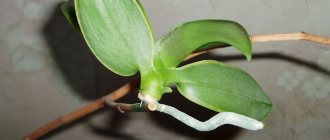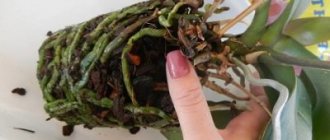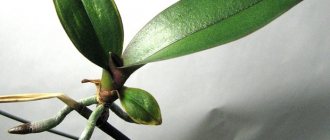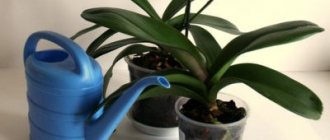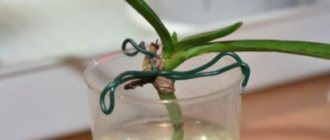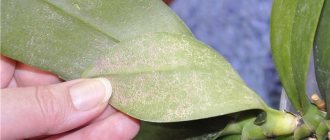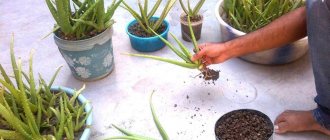Why can a flower be left without a root system?
To monitor the growth of the orchid and its condition, experts recommend growing these flowers in transparent containers. This is how you can see its roots, which should be light green in a normal, moist state:
- If their color turns pale green or white, and the leaves begin to fade, then the plant needs watering.
- If the soil is not selected correctly, or the pot chosen during replanting is too large, then diseases of the root system may occur.
- The cause may also be particles of earth in the soil - they cause stagnation of water and prevent the flow of oxygen, which leads to the death of roots.
There are other reasons for the death of the root system:
- High humidity, poor lighting. The orchid has an unusual root structure.
Flowers do not have root hairs, through which plants usually receive moisture. The orchid root is covered with hollow cells that absorb moisture through capillaries and then transfer it to the next layer until it reaches the center of the root, from where it will move upward to the flowers. The rate of moisture absorption directly depends on the light level. The brighter it is, the more moisture the plant consumes. - Soil compaction. Over time, the substrate changes its properties, begins to become very compacted, or crumbles into small pieces. As a result, the supply of nutrients to the plant is disrupted. To prevent this, it is necessary to monitor the condition of the soil and change it if necessary.
- Root burn by fertilizing. Orchids are too sensitive to phosphorus and potassium salts. With a high concentration of these components in fertilizers, the roots of the flower can get burned, after which their functioning is impaired. To save the plant, only transplantation into new soil is allowed.
- Incorrect transplant. When replanting a plant, there is a risk of damaging the root system, after which a center of rot may appear in this place. If you do not notice this in time, the disease can spread to the entire plant, leading to its death.
- Pest attack. If problems arise with the root system, this may be due to the appearance of click beetles that have laid larvae in the substrate.
They feed on root shoots, as a result of which the plant ceases to receive the required amount of water. The main symptom is wilting leaves. It is necessary to immediately wash the roots and change the soil. For 10 days after resuscitation of the flower, it is forbidden to water it. At this time, all the larvae will die because they cannot tolerate drought. - Fungus. As a result of infection by the fungus, the root system begins to rot. Only removing dead parts and treating with special means helps.
Features of animation
Each individual case of resuscitation of a phalaenopsis orchid has its own characteristics; all plants cannot be revived using one method:
- For a trunk without leaves, germination only in a greenhouse is suitable; it is important to provide the required amount of light. But direct sunlight can completely kill the plant;
- without a growth point , an orchid can also survive; for this, it is reanimated in an ordinary pot, which is selected under the rhizome. Particular attention should be paid to watering; it is carried out by spraying and very carefully so that only the roots are moistened;
- If the roots rot, the trunk can be restored without using a substrate. After trimming all affected roots and treating with a fungicide, the plant can simply be attached to a single piece of foam and simply hung in partial shade;
- allowing the soil to dry out will also affect the roots, only the effect will be exactly the opposite of rotting. The roots will simply dry out . To restore them after the preliminary preparatory process, the trunk is restored in a greenhouse, or new roots are sprouted above water;
Advice! A good effect will come from pre-soaking the orchid in a stimulant preparation.
- In case of hypothermia , each case is studied separately, because the damage can be completely different. If the leaves and peduncles are caught, then after a long rehabilitation the trunk will survive. The same will happen with frozen roots. If the growth point has been damaged, namely, it has become transparent and watery, then no amount of resuscitation will help;
- Sunburn cannot be treated; the plant can simply be protected from it. It is enough to simply move the pot to another window or build a small shelter. Affected leaves are usually cut off and disposed of;
Sunburn.
- The flower stalks of the phalaenopsis orchid dry out in two cases (depending on the cause and the method of restoration chosen): from lack of moisture;
- from excess feeding.
Consequences
The consequences of the death of the orchid's root system are quite obvious - gradual withering and death of the flower. A plant cannot exist without these important nutritional organs. If you suspect that roots are dying, it is necessary to inspect them and determine the extent of damage. You can tell if there are problems by the following signs:
- color change;
- slimy and wet areas from which water flows out when pressed;
- presence of collapsed areas.
How to resuscitate at home?
The following describes in detail what to do if the flower has no roots.
Inventory preparation
Depending on the method of resuscitating a sluggish, rootless plant at home, the required set of tools will be slightly different, but the main items that are needed are:
- scissors or pruning shears, pre-treated with alcohol or other antimicrobial compound;
- a vessel where the plant will be temporarily placed;
- activated charcoal or charcoal, for processing sections;
- clean, well-filtered or boiled water.
Removing from the pot and trimming the roots
- To inspect the root system, it is necessary to remove the plant from the pot and clean the root system from the substrate.
- Small particles of soil can be washed off with water. Healthy roots will be dense, elastic and have a uniform surface. Young shoots are lighter in color and when immersed in water they will acquire a greenish tint. Old shoots have a gray or brownish tint. Damaged roots that no longer nourish the leaf rosette become soft and damp to the touch.
- Damaged and problem areas are cut off, after which the cut areas must be treated with crushed activated carbon or ground cinnamon, which is also a natural antiseptic.
- After drying, it is useful to immerse the roots in a fungicide solution for 10-15 minutes.
This reduces the risk of fungal infection. If there is mold on the roots, it is necessary to treat them with a solution of potassium permanganate.
Causes of the disease - how to distinguish living roots from rotten ones?
Often, orchids rot in the autumn-winter period due to lack of sunlight and lower air temperatures. The plant goes into hibernation, and it is difficult to determine its condition by external signs. The leaves remain dense and green, but the roots stop drinking moisture, resulting in an accumulation of liquid in the flower pot. If a flower remains in this state for a long time, the roots begin to rot from excess water, and the orchid dies.
When examining a tropical beauty, pay attention to the following indicators:
- condition of the deciduous part (if the roots have rotted, the leaves become sluggish and quickly turn yellow);
- the state of the shoot (if the stem turns yellow from top to bottom, this is a sure sign of ill health);
- lack of flowering (the damaged rhizome of the plant cannot supply energy to the buds due to its unhealthy state);
- stability (tilting the bush to one side or strong swaying when lifting the pot indicates that the perennial has nothing to hold on to the ground).
If you notice at least one sign from the list presented, immediately remove it from the soil to determine the extent of root damage. Living roots differ from dead ones according to the following criteria:
- color (a strong branch has a whitish or greenish tint; rotten stems have a black or brown color);
- to the touch (a healthy root is elastic and dense, while dead roots have a hollow texture and crumple when touched).
Often representatives of the Orchid family disappear due to improper maintenance and due to damage by pathogenic organisms. The plant can be saved at home before it dries out completely. Too much watering has a detrimental effect on the nutrition of the crop. Paradoxically, the roots will not be able to absorb moisture if the substrate is constantly wet. The soil must dry out between irrigation; it is necessary that the rays of the sun penetrate into it, drying the soil. Without proper lighting, water will not reach the leaves.
Plant the flower in a pot with transparent walls. Thanks to this, you can control the condition of the soil and roots.
Rotting is caused by dense soil. Fresh, loose substrate that lies loose in the pot contains certain nutritional elements. Air gaps allow the roots to absorb oxygen and enrich the entire bush with it. Over time, the soil becomes compacted and leads to the “suffocation” of the orchid. Therefore, always monitor its condition; it should not sag much.
Tender roots are sensitive to concentrated fertilizers and the frequency of their application. Excessive doses of fertilizers can lead to burns and death of root tissue. Use only those fertilizers that are intended for Orchids. Fertilize no more than twice every 30 days.
Dying roots can cause technical damage, for example during replanting. If the broken shoots were not treated with special disinfectants, the result of the work done will disappoint you. Tissues affected by bacteria are not able to supply moisture to the leaf plates, and staying in a humid environment leads to rotting.
Is it possible to save a sluggish and damaged flower: methods of restoration
How to help grow using a greenhouse?
If you have a window greenhouse, in which it is possible to maintain optimal temperature conditions and humidity levels, there is a high chance of resuscitating the plant. To do this you need to do the following:
- line the bottom of the greenhouse with expanded clay;
- lay steamed sphagnum moss on it;
- A leaf rosette is placed in the ground.
To grow roots up to 4-5 centimeters, it is necessary to maintain humidity in the greenhouse at least 75-95% and temperature within +23°C, +27°C. The plant should be well lit for at least 12-14 hours a day. If all conditions are met, the chances of recovery are at least 80%.
During maintenance, the greenhouse must be ventilated at night and watered as the substrate dries. If there is no greenhouse, then you can use improvised means, for example:
- cuttings of large bottles;
- confectionery boxes.
The main thing is to create a microclimate inside it in which the plant will recover and develop faster.
How to grow without a greenhouse?
For this purpose, special preparations are used as bait, which provide the plant with the necessary amount of nutrients due to the absorption capacity of the leaves. Before planting, the soil is slightly moistened.
To avoid damaging the plant, it is best to carry out the procedure in the morning or evening to avoid exposure to sunlight and not cause a chemical burn to the plant. It is necessary to prevent bait from getting on the buds and flowers.
How to grow by planting in a substrate?
A substrate is a mixture of various components that is necessary to create a comfortable habitat for the flower, as close to natural as possible. Orchids typically grow on trees, absorbing moisture and nutrients from the bark. Therefore, it is necessary to make a mixture that will be light, environmentally friendly and have good drainage characteristics that cannot be obtained in ordinary soil.
The following components are used to prepare the mixture:
- tree bark;
- sphagnum moss;
- ash;
- fern roots.
These components are basic and can be supplemented if necessary:
- coconut fiber;
- dry leaves;
- peat.
In some cases, expanded clay is added for better drainage characteristics.
The flower is thoroughly cleaned of damaged and rotten roots and planted in a prepared pot. After this, you need to carefully monitor the humidity level of the substrate so that it is always slightly moist. There is no need to water the plant regularly so that the water does not stagnate at the bottom of the pot, otherwise the rotting process will resume.
The temperature in the room with the plant should be between 23-25 degrees. If the temperature drops below 20°C, the growth of roots will slow down, and the process of reproduction of microbes and bacteria will noticeably accelerate.
How to put in water to form a root system?
How to grow roots in water:
- If the plant is rootless, then to grow new organs, some gardeners recommend placing it in a container of water. In practice, it is not always possible to save a plant with a severely damaged root system, so for a greater supply of nutrients it is recommended to add a teaspoon of sugar syrup or liquid honey per liter of liquid.
- Another way to root:
- place the plant above water;
- all rot is thoroughly cleaned, the cut area is treated with activated charcoal or charcoal, and left to dry for 8-10 hours in a well-lit room, but without direct exposure to sunlight;
- after which the plant is placed in a glass vessel filled with filtered or boiled water so that the neck does not touch the water, but is located at a distance of 2-3 centimeters from it.
During resuscitation, you must be prepared for the plant to lose most of its turgor, but this is normal, since this is necessary to compensate for the distribution of nutrients and restore the root mass.
From the video you will learn how to revive an orchid without roots in water:
How to stimulate organ growth in a baby?
How to grow roots for a baby:
- We prepare an aqueous solution with a growth stimulator, where we place the plant cleaned of old substrate and rot.
- Dissolve a tablet of activated charcoal or charcoal in a bowl of boiled water, heated to 23-25°C.
- We place the orchid in a basin, where further restoration of the root system will take place.
All this time it is necessary to maintain good air circulation and high humidity in the room. If some amount of water has evaporated from the container, it must be replenished to a sufficient level. Only preheated water should be added so that there is no temperature difference.
Landing in the ground
The rooting process is considered successful if the orchid has formed 3-5 new roots 4-5 cm long . At this stage, they begin directly to transplant the plant into the substrate.
Rules for planting and caring for an orchid with an undeveloped root system:
- The container must correspond to the volume of the rhizome, that is, for an orchid with several roots, you need to take a flower container no more than 10 cm in diameter, regardless of the size of the leaf rosette. For stability, the pot can be placed in a large pot. with a heavy bottom.
- In the first 2 months after transplantation, excessive watering is not recommended. Instead, the top layer of the substrate is irrigated with a fine spray bottle. You can moisten the substrate by immersing it in a pan of water for 10-15 minutes, but not more than ¼ of the height of the container.
- For feeding, only specialized complex fertilizers for orchids are used in very low concentrations.
- The reanimated plant requires intense lighting, but without exposure to direct sunlight. Daylight hours are at least 12 hours.
- During the recovery process, the orchid has weak immunity. To prevent infection through the soil, the ingredients of the soil mixture must be boiled or fried in the oven. The container is also disinfected by thoroughly washing it with soap or dishwashing detergent.
Recommended soil mixture composition:
- bottom layer – vermiculite (up to 1/4 of the height of the pot);
- sphagnum layer – 2-3 cm;
- large (2-2.5 cm) pieces of coniferous tree bark (up to ½ the height of the pot);
- a mixture of fine and medium fraction bark (1-1.5 cm), pieces of charcoal, coconut fiber in equal proportions.
Care
In order for the plant to recover and continue its normal development, subsequent care is necessary. To achieve this, normal lighting is maintained 12-14 hours a day. The temperature should be within 22-26 degrees Celsius. To determine humidity, it is better to use a special device, since orchids are quite sensitive to humidity and do not like the substrate to dry out, as well as strong moisture.
The most common mistakes when rooting
To avoid mistakes, a novice gardener must adhere to the basic rules of resuscitation :
- The plant is placed in a well-lit place;
- The room temperature must be at least 23 degrees Celsius;
- There must be high humidity;
- Do not pick off yellowing leaves.
By adhering to these rules, you can be sure that the orchid will grow roots .
In what cases is it no longer possible to save?
It will not be possible to save a damaged plant if not only the root system is damaged, but also the stem of the plant. Careful and constant care will also be required, otherwise the recovery process will slow down and the plant will die.
It should be remembered that damage to the roots of an orchid is a fairly common occurrence. This is a problem for beginners who violate the rules of plant care, or the consequences of violating regular care. The main thing is to detect the problem in a timely manner and choose the most appropriate method of resuscitating the orchid, so that limp leaves and damaged roots become a thing of the past forever.
If you find an error, please select a piece of text and press Ctrl+Enter.
Resuscitation of a flower without leaves
Resuscitation of an orchid that has problems with leaves is carried out in different ways. It is important to know that aging and yellowing of the leaf is a natural process. It is considered normal if the leaf lives for several months and dies. If the leaves fall quickly, then perhaps the plant is entering a period of dormancy - this reaction is typical for dendrobiums.
In monopodial orchids, for example, Phalaenopsis, the death of the two lowest leaves is considered natural. Sympodial varieties, for example, Dendrobium, can get rid of foliage once every 1-2 years. The leaves of Dendrobium Nobile are characterized by a relatively short life span - up to 18 months.
Some species shed them during the dormant period, for example, Kalantha. But in the new phase the plant produces a lot of new foliage. Tropicanas retain foliage for many years.
